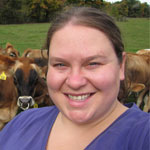
We’ve never been the herd with the lowest somatic cell count (SCC). Our numbers have always bounced around, and we’ve literally tried everything to stabilize them. We still work to keep them at low levels, but once the quality bonuses went away, we stopped trying to make it as low as possible.
Here’s the thing about SCC, it’s not the only indicator of udder health. Yes, if you have cows with mastitis, your SCC will go up. And yes, if you treat those cows it will go down. But that’s not the only thing that causes increases.
Somatic cells are body cells. Every living thing has them. And the more stressed we get, the more somatic cells our body releases. So, it makes sense that when a cow has mastitis, an infection, her body would secrete more somatic cells. But mastitis isn’t the only thing that can stress a cow out.
It’s common for an individual cow’s SCC to be higher right after she calves, know why? Calving, barring any major illness or random event, is the most stressful thing a cow will endure during her lactation. Weather can play a big factor. Typically, as the temperature rises each summer, so does SCC. What about a stressful working environment? Some people just generally run at a higher stress level and cows can sense that. One of the biggest impacts on SCC that I’ve seen, aside from udder health, is lameness. And there’s a story behind how I discovered it.
When I lived in New Zealand, cows would have to walk up to a mile to get to the milking shed (parlor). So there was always a paddock or two available right next to the shed for the sick herd. By mid-season, the sick herd was mostly lame or old cows that couldn’t handle the walking. On the days we’d pull more than one lame cow out of the herd, we’d see the SCC drop a bit by the next milking.
We focus so heavily on udder health that we tend to underestimate how stressful lameness can be. Our cows may not have to walk a mile, but they do have to walk to everything they need — water, feed, stalls, and the parlor. Imagine doing that with a sore hip or blistered feet.
I know the usual channels farmers take when our herd SCC goes up and still agree that udder health should be the first culprit investigated. I’m just saying that it’s not always that simple or singular. Knowing your cows and how they speak to you is half the battle.

The author dairies in partnership with her parents and brother at Spruce Row Farm in Pennsylvania. Jessica is a graduate of Pennsylvania State University, and since 2015, she has been active in promoting dairy in her local community. You can find her and her 250 Jersey cows on Facebook at Spruce Row Dairy or on Instagram at @seejessfarm.








